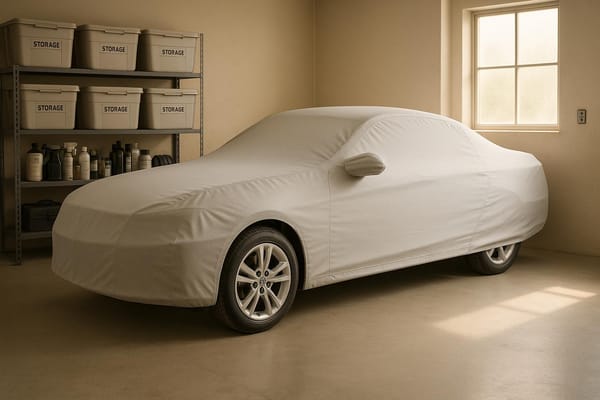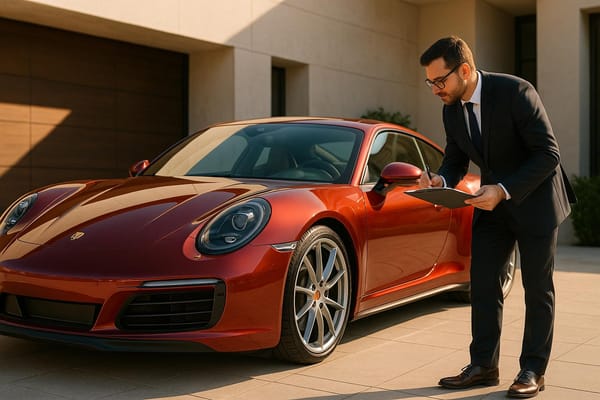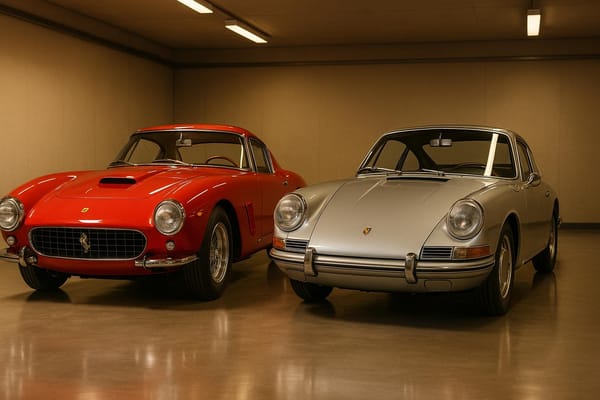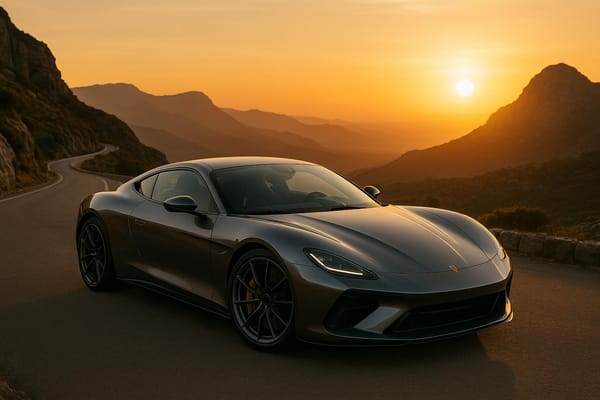Provenance vs. Price: Auction Trends Explained
Explore how provenance, condition, and market forces shape classic car auction prices, revealing trends and investment insights.
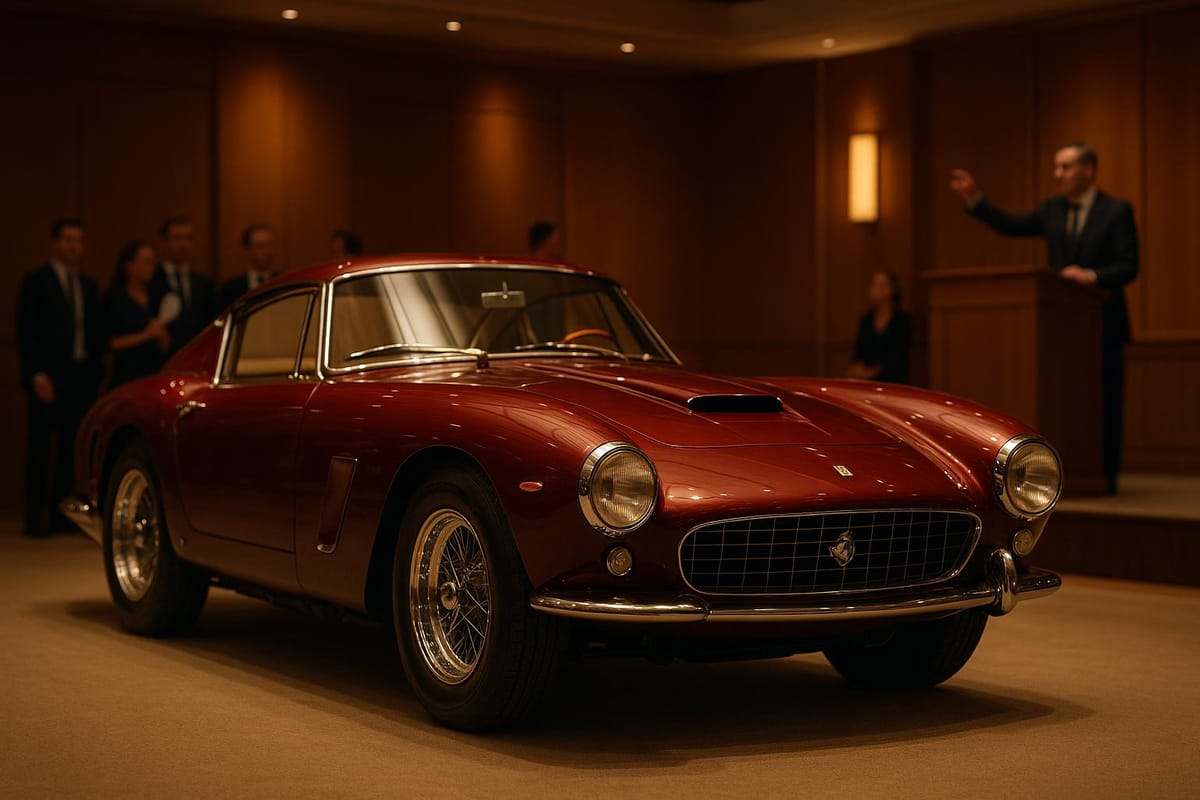
Why do some cars sell for millions more than others? It often boils down to provenance - a car’s unique history - and market forces like condition, trends, and fees. Here’s what you need to know:
- Provenance Matters Most: Celebrity ownership, racing history, and detailed documentation can multiply a car’s value. For example, Steve McQueen’s Porsche 911S sold for 19 times its usual price (£1.1 million).
- Condition Drives Value: Cars in excellent condition (#1 or #2) appreciate faster. A top-condition Fox-body Mustang, for instance, is worth 55% more than one in poor condition.
- Market Trends Shift: Cars from the 1980s and 1990s are booming, with some models climbing by 78% in value over three years. Meanwhile, pre-war cars have dropped by 11%.
- Auction Costs Add Up: Buyer premiums and seller commissions can heavily impact final prices, with fees ranging from 5% to 12.5% plus VAT.
Key Example: A 1962 Ferrari 250 GTO sold for £41.3 million in 2023, thanks to its rare racing pedigree and factory provenance.
In a market worth £640 billion in 2024, understanding the interplay between history, condition, and market forces is critical for collectors and investors alike.
Classic Car Buyers Beware - The Carmudgeon Show w Jason Cammisa & Derek Tam-Scott - Ep. 190
What Makes Strong Provenance
Provenance can significantly boost auction values, and three factors play a key role: racing history, celebrity ownership, and comprehensive documentation.
Racing History and Major Events
A car's track record can greatly influence its market value, especially when its achievements are well-documented. Take Michael Schumacher's Ferrari F2001, for example - it sold for an impressive £5.85 million, setting a record for modern-era Formula 1 cars at auction.
Interestingly, even cars with less stellar racing careers can fetch high prices if they have a solid paper trail. A Ford GT40 that crashed during the 1966 Le Mans race still managed to sell for £10.1 million, while another GT40, which finished third in the same race, brought in £7.64 million in 2018.
"Several factors determine a race car's value: How popular is that make and model, who drove it, how did they do, and how original is the car." - Vintage Racing Expert
Racing pedigree is undeniably important, but the allure of celebrity ownership takes it to another level.
Famous Previous Owners
When a car has been owned by a celebrity - especially someone connected to motorsport or car culture - it can dramatically increase its worth. The premium depends on the celebrity's status and the car's significance. For instance, a 1987 BMW M5 once owned by the King of Sweden sold for £109,200, representing a 55% increase over its typical market value.
While celebrity ownership adds glamour, the importance of thorough documentation cannot be overstated.
Documentation Quality
High-quality documentation is essential for maximising a car's value. This includes:
- A complete and verifiable ownership history
- Detailed service and maintenance records
- Period photographs and race results (for competition cars)
- Original factory paperwork
- Restoration records and receipts
"A full unbroken and authentic set of documents which identify in a reliable manner who has owned the car, the uses that it has been put to and a description of its service history and any restoration, rebuilding, or reconstruction work that the car has experienced throughout its life since originally leaving the factory." - Mr. Justice Otton, Law Courts of London
For example, a 1957 Triumph TR3 with its original paint and comprehensive records, including period photos and Daytona race results, highlights how meticulous documentation can elevate a car's value compared to similar models without such history.
Key Price Drivers Beyond History
Auction prices aren't just about a car's story. Factors like condition, market trends, and auction fees also play a big role in determining value. Let’s break this down further.
Original Parts and Condition
For cars older than 15 years, condition is everything. Data from the Hagerty Price Guide shows a strong link between a car's condition and how much its value increases over time. In fact, over the last five years, cars in excellent condition (#1 and #2) have gained value much faster than those in fair or poor condition (#3 and #4).
Here are some standout examples:
- 1979–93 Fox-body Ford Mustangs: Cars in top condition (#1) are worth 55.2% more than those in poor condition (#4).
- 1968–74 Ferrari Dino 246: The value gap between top and poor condition is 18.4%.
- 1978–95 Porsche 928: A 40.3% difference in appreciation rates between the best and worst conditions.
"The number one differentiator in price among cars over 15 years old is typically the most straightforward one: condition." – Brandan Gillogly
Restoring a car to pristine condition isn’t cheap. Costs for paintwork, materials, and chrome restoration have skyrocketed - some projects now exceed £50,000, with certain expenses doubling in recent years.
Market Forces
The broader classic car market has seen some clear trends in recent years:
- Only 8% of models have increased in value.
- 46% of models have dropped in value.
- The remaining 46% have stayed flat.
Interestingly, cars from the 2000s bucked the trend, with an 8% rise in value. Meanwhile, pre-war vehicles have taken a hit, with an 11% decline. Lamborghini, on the other hand, enjoyed a 10% average value increase in 2024.
"50s to 60s cars have fallen around 10 per cent each between 2023 and 2024. Then again, every single decade when you look at the rest of the car market fell in 2024 versus 2023." – Giles Gunning, The Classic Valuer co-founder
While provenance undoubtedly adds value, these market trends show that external factors can have just as much influence on final auction prices.
Auction Fees and Costs
Auction fees are another key factor that can significantly impact the total cost of a transaction. Just like market trends shape car values, these fees directly affect how much buyers and sellers ultimately pay.
| Auction House | Seller's Commission | Buyer's Premium | Additional Fees |
|---|---|---|---|
| CCA Everyman | 5% + VAT (min £350) | 12.5% + VAT | £250 + VAT cataloguing fee |
| Barons Classic | 5% + VAT (min £150) | 12.5% + VAT | £150 + VAT minimum |
| H&H Auctioneers | 5% + VAT (min £250) | 12.5% + VAT* | From £250 + VAT entry fee |
*H&H applies a reduced 10% + VAT rate for amounts exceeding £250,000.
For instance, if a car sells for £100,000 at CCA Everyman, the buyer would need to pay an additional £12,500 in premiums (excluding VAT). The seller, meanwhile, would face a £5,000 commission fee plus cataloguing charges.
These costs add up quickly and can make a significant difference in the final financial outcome of an auction.
Record Sales Through Provenance
Ferrari 250 GTO Sales Analysis
The Ferrari 250 GTO stands as a prime example of how a car's history can dramatically influence its value at auction. In November 2023, a 1962 Ferrari 330 LM / 250 GTO (chassis 3765) fetched an astounding £41.3 million at Sotheby's New York auction. This sale made it the second-most expensive car ever auctioned.
What makes this car so valuable? Its unique history. It’s the only GTO Tipo 1962 raced by Scuderia Ferrari, boasts a class win at the 1962 Nürburgring 1000 KM, and is one of just 36 produced between 1962 and 1964.
"The Ferrari 250 GTO is the motoring market's equivalent of Van Gogh's 'Sunflowers' and a talisman for any top-end collection."
- James Knight, Group Motoring Chairman at Bonhams
This sale eclipsed the previous record of £38.7 million set in 2018, with the car's factory team provenance adding a premium of approximately £2.6 million. It’s a clear demonstration of how a racing pedigree can elevate a car’s worth. Similarly, Group B rally cars reflect this trend, with their competitive history significantly boosting their market value.
Group B Rally Cars
Group B rally cars have seen a surge in value, with their racing heritage driving auction prices to impressive heights.
| Model | Sale Price | Key Provenance Factors |
|---|---|---|
| 1985 Lancia Delta S4 Stradale | £425,000 | One of 200 built; less than 1,600 km from new |
| 1985 Audi Sport Quattro | £387,000 | Single owner; 18,388 km from new |
| 1982 Lancia 037 Stradale | £361,000 | Factory-original condition |
The Lancia Delta S4 Stradale’s record-breaking £425,000 sale at RM Sotheby’s 2017 Villa Erba auction highlights how factors like low mileage and pristine condition can significantly enhance value. Its rarity as one of only 200 road-legal examples built for Group B homologation added to its appeal.
Competition cars also follow this pattern. For instance, the Subaru Impreza S6 WRC that won the 2000 Rally GB, driven by Richard Burns, set a record for the model by selling for £610,000 at auction.
"This transaction adds a new chapter to a vehicle with an unmatched legacy... Now, it ranks among the most expensive cars sold at auction, a true testament to its singular place in history."
- Gord Duff, RM Sotheby's Global Head of Auctions
These examples make it clear: a car's racing history and preserved original condition can multiply its value at auction - sometimes by as much as three times compared to unraced counterparts.
Market Changes and New Tools
Digital Authentication Methods
The classic car auction world is evolving rapidly, thanks to blockchain technology and digital authentication tools. Sotheby’s collaboration with Polygon Labs is a prime example. By embedding ownership history and authenticity certificates into NFTs, buyer confidence soared by 74% during a 2023 trial.
Why does this matter? Traditional auction platforms face massive challenges, including fraud-related losses amounting to approximately £950 million annually. Blockchain steps in as a game-changer, offering a transparent and tamper-proof way to record transactions and verify item histories. Platforms like Auctonomy have already demonstrated its potential, cutting counterfeit listings by an impressive 92%.
"Blockchain is the brushstroke modernizing the auction canvas." - Charles Stewart, Sotheby’s CEO
But it’s not just about technology. The market itself is shifting, with a noticeable surge in interest for cars from the 1990s.
1990s Cars Market Growth
Cars from the 1990s are experiencing a boom like no other, with their values climbing by an average of 78% in just three years. Some standout models highlight this trend:
| Model Type | Previous Value (2015–2018) | Current Value (2024) | Increase |
|---|---|---|---|
| Ford Bronco (1990s) | £10,500 | £20,800 | 98% |
| Early '90s Miata | £7,800 | £11,000 | 41% |
| Low-mileage 1990s Pickups | £23,000 | £39,000–£55,000 | 70–139% |
"Values, for the last three years, for cars and vehicles from the 1990s have increased the most out of any decade." - Brian Rabold, Vice President of Automotive Intelligence at Hagerty
What’s driving this surge? Millennials and Gen Z buyers are playing a key role. Data shows that 32% of Gen Z and 30% of millennials have owned classic enthusiast cars. These generations are drawn to the unique mix of analog charm and early digital tech found in 1990s vehicles.
Electric Conversion Impact
Electric conversions are another factor shaking up the market. While opinions remain divided, these conversions can significantly boost a vehicle’s value. Some examples include:
- MG MGB Roadster EV conversion: £108,000 (20 times its original value)
- Aston Martin DB6 electric conversion: £730,000
- Fiat 500 electric conversion: £40,000 (including parts and labour)
However, not all classic car enthusiasts are on board. A striking 82% of classic car owners oppose electric conversions.
"Converting to electric destroys the sound, feel, driving experience, and even the smell of a classic. If you spend a huge amount of money converting, it should not be classified as a classic anymore. The whole point is to retain the age and history, not to mess with it. I don’t know of anyone in the trade who would want to do this." - Richard Perry, Classic Car Owner
On the financial side, electric conversions can cut annual fuel costs dramatically - from around £1,060 to just £240 for a car driven 5,000 miles a year. But these savings come with hefty upfront costs. Conversions range from £10,000 for basic kits to as much as £180,000 for full restorations. Balancing these costs with the potential benefits is a decision every owner must weigh carefully.
Conclusion
The analysis above highlights how provenance continues to influence auction trends in the classic car market.
The relationship between provenance and price is constantly shifting, shaped by market trends and advancements in technology. In 2024, the global value of collectible cars was estimated at around £640 billion. However, the market saw a 3.5% dip, as reported by the AssetClassic Auction Index.
Historical examples underline the unpredictable nature of provenance on valuations. Take the 1959 Ferrari 250 GT LWB California Spider Competizione: it sold for £3.96 million in 2007, soared to £14.39 million in 2017, but dropped to £7.57 million by 2025. This pattern reveals that even a flawless history isn’t a guarantee for consistent appreciation.
"This is a lovely car with a significant racing history, impeccable provenance and no stories. It's worth top dollar, but in 2025 'top dollar' apparently means 60 percent of what it meant in 2017." - Rick Carey, Auction analyst and industry expert
Celebrity ownership remains a powerful factor in boosting value. For instance, Steve McQueen's Honda CL77 Scrambler fetched £92,000, while a similar model sold for just £7,600. Meanwhile, younger collectors are showing a growing preference for cars from the 1980s and 1990s. Auction houses are increasingly focusing on vehicles with a minimum value of £400,000. With digital authentication becoming more sophisticated, identifying cars with compelling provenance is now more critical than ever.
"Collecting is done best when it follows your individual passions. Genuine interest will put you in a far better position than hype or speculation ever will." - Thomas Ruggie, ChFC®, CFP®, Founder and CEO, Destiny Family Office
As the market evolves and verification technologies improve, platforms like MARQHAUS provide a tailored space to explore rare supercars and investment-grade classics that stand out for their exceptional provenance.
FAQs
How does owning a car previously driven by a celebrity affect its auction value?
Celebrity ownership can significantly inflate the auction value of a classic car, sometimes multiplying its price several times over. Cars previously owned by well-known figures carry a unique allure, turning them into prized collector's items. In certain cases, this connection to fame has boosted a car's value by as much as 500%.
This added worth comes from the fascination with celebrity culture and the sense of exclusivity it brings. A car linked to a famous individual isn’t merely a vehicle - it becomes a slice of history, making it especially appealing to collectors and enthusiasts.
How does digital authentication impact the classic car auction market?
Digital authentication is transforming the world of classic car auctions by offering a more reliable way to confirm a vehicle's provenance and history. Technologies such as blockchain and digital passports allow buyers to verify a car's authenticity with much greater certainty. This reduces the chances of fraud and builds stronger trust between buyers and sellers.
With this added layer of transparency, classic cars with verified histories often fetch higher prices at auction. Collectors value the assurance that comes with authenticated details. As these digital tools gain traction, they are changing how classic cars are bought and sold, creating a safer and more dependable marketplace for everyone involved.
Why are 1990s cars becoming more valuable at auctions?
Cars from the 1990s are experiencing a noticeable jump in value at auctions, fuelled by a mix of nostalgia, limited availability, and the increasing interest of younger collectors. With Millennials and Gen Z now reaching their prime earning years, many are eager to own the cars they once admired, creating a surge in demand for these models.
Models like the Nissan GTR Skyline and Ford Bronco have become particularly sought after, thanks to their rarity and iconic appeal. Over recent years, auction prices for cars from the 1990s have climbed steadily, reflecting their growing reputation as modern classics. This shift points to a broader trend in the collector car market, where vehicles once overlooked are now appreciated for their distinctive character and cultural relevance.

